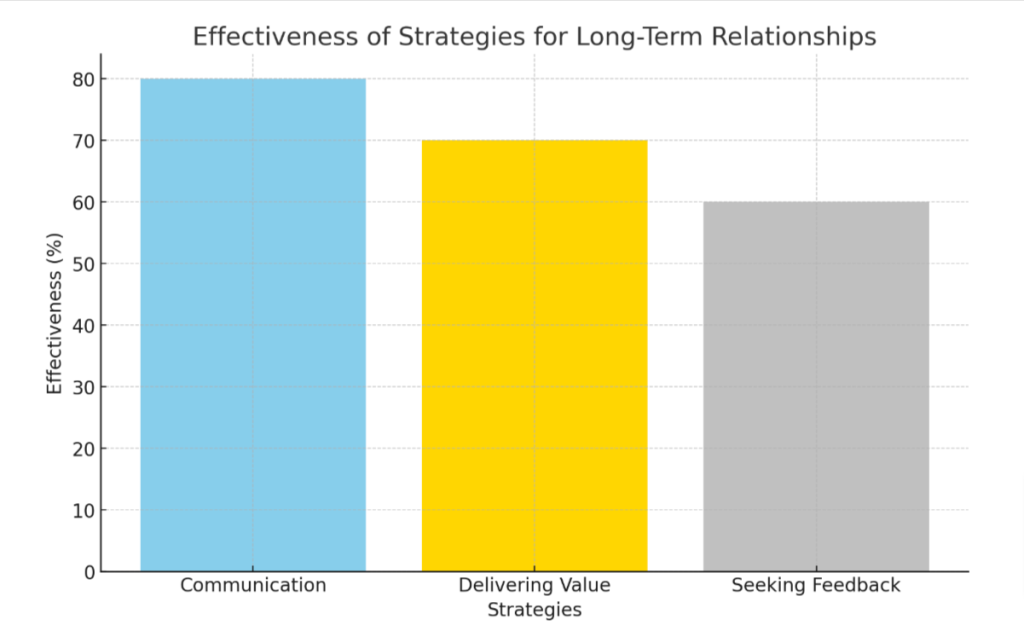The Art of Cultivating Long-Lasting Relationships
Are you struggling to build and maintain long-term relationships with your clients? According to the Harvard Business Review, companies that prioritize client relationships can increase their customer retention rates by up to 5%.
This blog post will reveal effective strategies for nurturing long-lasting connections with your clients. Ready to transform your relationship-building approach? Dive in!
Key Takeaways
- Knowing your clients’ needs and tailoring your approach to meet them is essential for building strong client relationships.
- Effective communication involves clear dialogue, active listening, and prompt responses to foster trust and mutual respect.
- Consistently delivering value and quality builds a strong foundation for long – term client relationships.
- Showing appreciation and recognition strengthens the bond between you and your clients.
Strategies for Building Long-Term Client Relationships
Know your clients, understand their needs, and tailor your approach to meet their specific requirements.

Know your clients
Knowing your clients is essential in building and maintaining strong client relationships. This means more than just recognizing their faces or names. You need to understand their needs, desires, and expectations.
Learn about their industries, market trends, and the challenges they face every day. Understand their goals and how your services can help them achieve these goals. Gathering this information requires effort on your part: conducting research, asking thoughtful questions during meetings, staying updated on industry news and trends are all parts of knowing your clients well.
A deep understanding of your clients will enable you to meet them where they are at and tailor your services specifically to meet their needs.
Effective communication
Clear and straightforward dialogue plays a critical role in building lasting relationships with clients. Effective communication goes beyond merely exchanging information, it involves understanding the emotion and intentions behind that information.
By truly listening to your clients’ needs and responding thoughtfully, you can foster an environment of mutual respect and trust.
Emails, phone calls, face-to-face meetings or even text messages – every interaction is an opportunity to express transparency and honesty. Respond promptly when they reach out, but don’t rush just for the sake of quickness; take time to provide them with thorough answers.
Demonstrate empathy by acknowledging their concerns before offering solutions – this shows your commitment towards enhancing their satisfaction throughout your customer journey together.
Deliver value and quality
Consistently delivering value and quality forms the bedrock of long-term client relationships. Every project, every piece of content should shout out your commitment to excellence.
Success in nurturing client relationships hinges on exceeding their informational needs while maintaining high standards. Make it your mission to always provide top-notch services that will enhance clients’ satisfaction and make positive impacts on their lives.
This not only promotes ongoing loyalty but also establishes a reputation for your brand as one that truly understands the significance of value and quality in enhancing connections.
Show appreciation and recognition
Showing appreciation and recognition is a vital aspect of building long-term client relationships. By acknowledging the efforts, support, and loyalty of your clients, you not only make them feel valued but also strengthen the bond between you.
Expressing gratitude for their business and offering sincere compliments can go a long way in fostering positive connections. In addition to words of appreciation, consider rewarding loyal customers with special incentives or exclusive offers to show that their patronage is truly valued.
This simple act of recognition can enhance overall customer satisfaction and encourage repeat business.
Seek feedback and improvement
To build long-term client relationships, it’s important to seek feedback and continuously improve. Actively asking for feedback shows that you value your clients’ opinions and are committed to providing the best experience.
Use their suggestions to make necessary improvements in your products or services, ensuring that you are meeting their evolving needs. By seeking feedback and constantly striving for improvement, you demonstrate your dedication to delivering quality and staying ahead of the competition.
The Importance of Authenticity and Empathy
Building genuine connections and understanding your clients’ needs are key factors in developing long-term client relationships that focus on making their lives better.
Building genuine connections
Building genuine connections is a crucial aspect of cultivating long-term client relationships. It goes beyond mere transactions and focuses on forging meaningful bonds with clients.
By taking the time to truly understand their needs and priorities, businesses can establish trust and authenticity. This involves listening attentively, showing empathy, and demonstrating a sincere interest in their success.
Building genuine connections lays the foundation for lasting partnerships that are built on mutual understanding and support.
In addition to understanding clients’ needs, building genuine connections also includes making efforts to improve their lives. This means going above and beyond to deliver value and quality in every interaction.
Businesses should strive to exceed expectations by consistently providing excellent service, personalized solutions, and helpful insights tailored specifically for each client’s unique circumstances.
Understanding your clients’ needs
Understanding your clients’ needs is essential for building strong and long-lasting relationships. By taking the time to truly understand what your clients want, you can tailor your products or services to meet their specific requirements.
This means listening actively and asking the right questions to gain insights into their goals, preferences, and challenges. When you have a thorough understanding of their needs, you can provide personalized solutions that address their pain points and add value to their lives.
Whether it’s delivering a customized project or creating relevant content, putting your clients’ needs first will help foster trust and loyalty while promoting positive experiences along the customer journey.
Making their lives better
Enhancing client satisfaction and quality of life is a key objective when building long-term client relationships. By understanding your clients’ needs, you can tailor your products or services to make their lives easier and more enjoyable.
Whether it’s delivering personalized solutions or providing ongoing support, the goal is to add value and improve their overall experience. By consistently striving to exceed expectations and addressing their pain points, you can foster trust, loyalty, and a deeper connection with your clients.
Maintaining Long-Term Client Relationships
Reward loyal customers with exclusive benefits, such as discounts and special offers, to show appreciation for their continued support.
Rewarding loyal customers
Rewarding loyal customers is a crucial part of building long-term client relationships. It shows appreciation and strengthens the bond between you and your clients. Here are some ways to reward and acknowledge their loyalty:
- Exclusive discounts or promotions: Offer special discounts or promotions exclusively for loyal customers as a token of gratitude.
- VIP treatment: Provide priority access to new products, services, or events to your loyal customers, making them feel valued and important.
- Loyalty programs: Implement a loyalty program where customers can earn points or rewards for their continued support.
- Personalized gifts: Surprise your loyal clients with personalized gifts that show you know and appreciate their individual preferences.
- Referral incentives: Encourage your loyal customers to refer new clients by offering incentives such as discounts or credits on their future purchases.
Staying in touch
Staying in touch with your clients is essential for maintaining long-term relationships. Regular communication helps to keep you on their radar and shows that you value their business and partnership.
Reach out through personalized emails, phone calls, or even face-to-face meetings whenever possible. By staying connected, you can stay updated on any changes or new projects they may have, ensuring that you are able to continue delivering value and meeting their needs.
Additionally, it provides an opportunity to address any concerns or issues promptly, showing your commitment to exceptional customer service.
Continuously improving and adapting
To build and maintain strong, long-term client relationships, it’s crucial to constantly improve and adapt. This means consistently looking for ways to enhance your products or services based on feedback from clients.
Actively seeking and implementing customer suggestions shows that you value their input and are committed to meeting their evolving needs. Additionally, staying updated with industry trends and technologies allows you to stay ahead of the curve and provide innovative solutions.
By continuously improving and adapting, you demonstrate your dedication to delivering exceptional value and quality to your clients.
The Role of Trust and Communication in Client Relationships
Trust and communication are essential for building strong client relationships. Discover the key strategies to establish honesty, open dialogue, and overcome challenges in order to foster lasting connections with your clients.
Read more to unlock the secrets of successful long-term relationship building.
Importance of honesty
Honesty is a fundamental aspect of building strong and lasting client relationships. When you prioritize honesty in your interactions, you establish trust and credibility with your clients.
Being transparent about your capabilities, limitations, and the progress of projects helps to foster open communication and maintain a positive working relationship. By being truthful in all aspects of your work, you show that you value integrity and have the best interests of your clients at heart.
Establishing open communication
To build strong and lasting client relationships, establishing open communication is crucial. It’s about creating an environment where clients feel comfortable expressing their thoughts, concerns, and needs.
By actively listening to their feedback and addressing any issues or questions promptly, you can foster trust and transparency. Regularly checking in with clients via phone calls, emails, or face-to-face meetings also allows you to stay connected and informed about their evolving needs.
Open communication paves the way for collaboration, problem-solving, and ultimately leads to better outcomes for both parties involved in the relationship.
Navigating challenges and conflicts
Navigating challenges and conflicts is a crucial aspect of building long-term client relationships. It is inevitable that disagreements or obstacles may arise at some point, but how you handle them can make all the difference.
By addressing these challenges head-on with open communication and a problem-solving mindset, you can work towards finding solutions that benefit both parties involved. This requires active listening, empathy, and a willingness to compromise when necessary.
Remembering the importance of maintaining trust and respect throughout this process will help strengthen your relationship with clients in the long run.
Conclusion
Developing lasting client relationships is essential for long-term success. By prioritizing effective communication, authenticity, empathy, and continuous improvement, you can cultivate strong connections with your clients.
Remember to show appreciation and recognition while staying in touch and rewarding loyalty. Building trust through honest interactions will help navigate challenges and conflicts. Take the long-term view in building relationships to foster growth and enhance client satisfaction.

